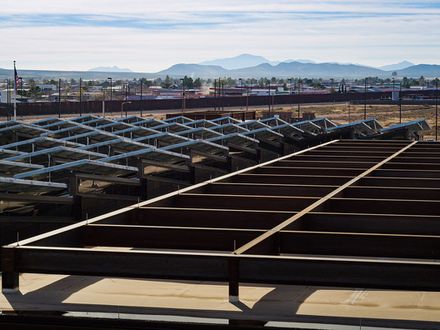United States Land Port of Entry
PHOTOGRAPHS
David Richter, Faia, Robert Reck
LEAD ARCHITECTS
David Richter, Faia; Elizabeth Chu Richter, Faia
MANUFACTURERS
Assa Abloy, Daikin, Honeywell, Landscape Forms, Sherwin-williams, Summit Brick Company, Thermafiber, Trane, Aeroflex, Alucobond, Amerimix, Anvil International, Bendpak, Cla-val Company, Cornerstone, Cummins, Fórmica, Lighting Protection Systems, Metron, Norcon Communications, Pemko, Proclad, Ranger Products, Serco, Superior Alarms, Tectura Design, Ultimate ConCrete, Warren Technology, tyler
STRUCTURAL ENGINEER
Walter P. Moore & Associates
PROJECT MANAGER
Stephen Cox, Aia
CIVIL ENGINEER
Jq
LANDSCAPE DESIGN ARCHITECT
Mrwm
PROJECT DESIGN
David Richter, Faia, Elizabeth Chu Richter, Faia
PROJECT TEAM
Sam Morris, Aia, Bob Mitchell, Aia, Lonnie Gatlin, Assoc. Aia, Albert Delgado, Assoc. Aia, Toan Huynh, Assoc. Aia
MECHANICAL, ELECTRICAL AND PLUMBING ENGINEER
Imeg Corp
COSTS CONSULTANT
Project Cost Resources Inc.
SECURITY CONSULTANT
Imeg Corp
LOCATION
Columbus, United States
FIRE PROTECTION CONSULTANTS
Jensen Hughes
GENERAL CONTRACTOR
Hensel Phelps Construction Company
CATEGORY
Port, Institutional Buildings
Text description provided by architect.
While providing safe, efficient, and expanded international entry processing for people and goods, this new port of entry design welcomes travelers to America with architecture that inspires and conveys our country’s better virtues.
It speaks of pride and even nationhood – but not by conventional form or metaphor. It is more about stewardship than ownership. It is more about inclusion than exclusion. It is more about performance than symbolism.
Colored brick strata and weathered steel extend the patterns and colors of the desert earth and grasses that reach the horizon. Terraced native landscaping and a sculpted ground plane convey the story of the scarcity, the harvest, and the power of water in the desert while moderating historical regional flood hazards to neighboring Puerto Palomas.
Shaded exteriors and daylit interiors shelter, diffuse, and harness the intense desert sun. The design process embraced the myriad technical, operational, performance, human and environmental challenges that are endemic to any port of entry, particularly one at a location of extraordinary natural beauty and resource.
An integrated design strategy front-loaded technology, research, and detail solutions allowing technical disciplines and performance-based details to be knitted into the visible architectural fabric – creating both a physical and intellectual transparency.
Architecture that serves and respects all people, embraces culture, conserves resources, nurtures ecology, protects habitat, celebrates diversity and conveys a love of the land.
The architecture is egalitarian – its patterns, scale, daylight, detail, and dignity equally applied to all parts of the building, all workers, and all visitors.
The scale is human and humble. It looks outward more than inward. Imagery is not born of pomp, power, or even of history or tradition – but simply of love of the vast desert land, sky, and water that itself knows no border.
It is nevertheless aspirational. It is about ideas and virtues that join two countries crossing the border as freely as the 800-plus school children that cross twice a day, every day.
The design's integrated and expressed response to the breadth of sustainable design opportunities is the mechanism for creating and conveying this message.
The rhythm and silhouette of photovoltaic, clerestoried roof monitors echo distant mountains.


















